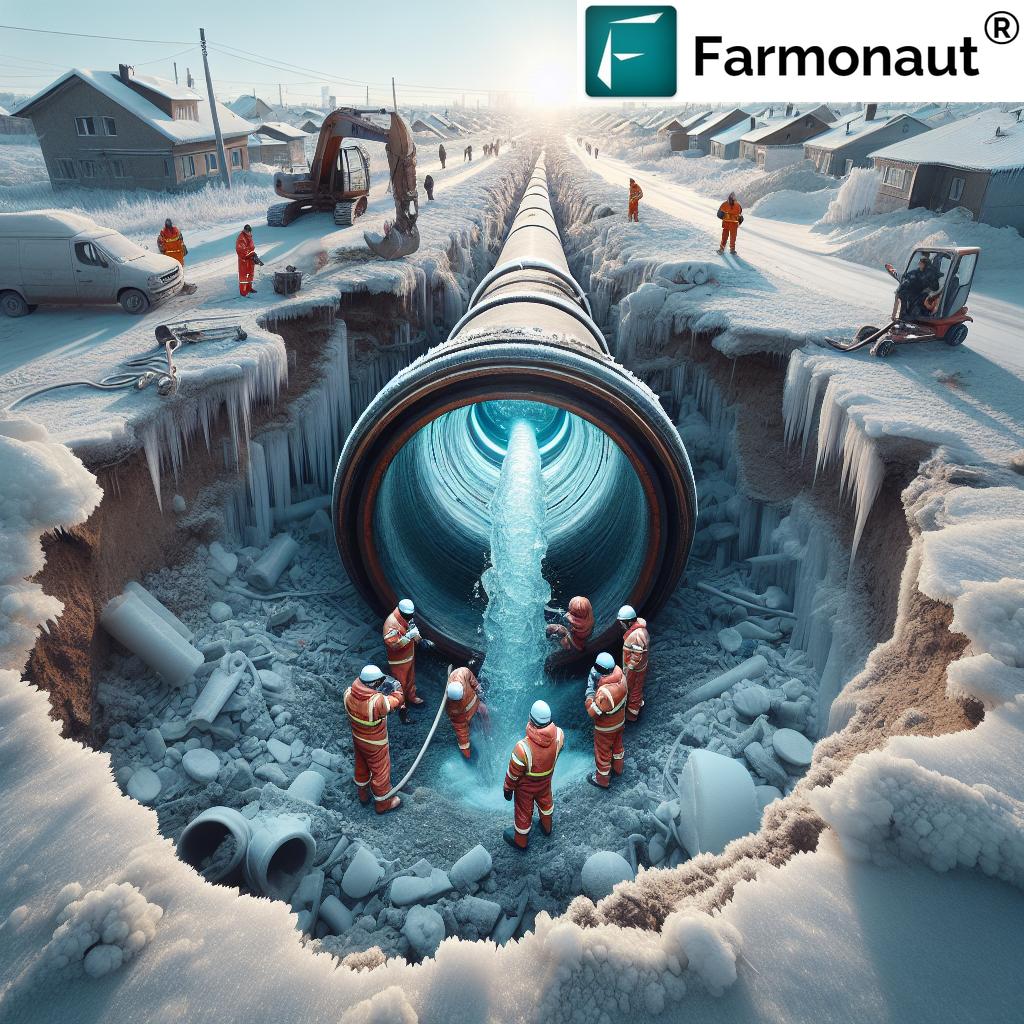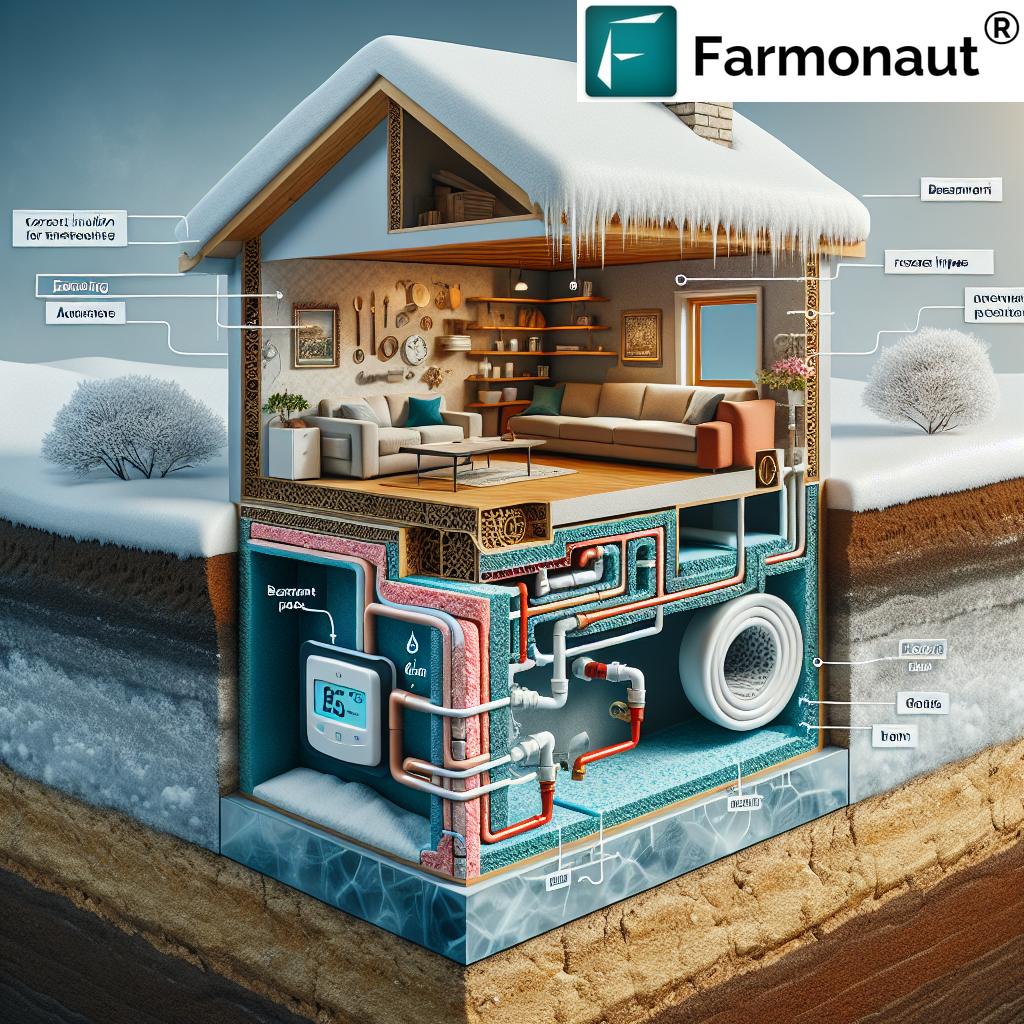Bozeman’s Winter Water Woes: Expert Tips to Prevent Frozen Pipes and Main Breaks
“Bozeman’s aging water system faces challenges with frost depths reaching up to 8 feet, causing pipe breaks and service disruptions.”
As winter tightens its icy grip on Bozeman, our community faces a critical challenge: protecting our water infrastructure from the harsh realities of freezing temperatures. In this comprehensive guide, we’ll delve deep into the causes behind burst pipes, explore the city’s efforts to maintain our aging water systems, and provide you with expert advice on safeguarding your home against winter’s wrath.
Understanding Bozeman’s Winter Water Challenges
Bozeman’s northeast neighborhoods have recently experienced significant disruptions due to water main breaks. These incidents serve as a stark reminder of the vulnerabilities in our water system during extreme cold spells. Let’s examine the factors contributing to these issues and how our city is responding.
The Perfect Storm: Frost Depth and Soil Shifting
Shawn Kohtz, Bozeman’s Utility Director, explains the primary culprit behind recent water main breaks: “The extreme cold temps have caught up with our water system. We have had a number of water main breaks over the last few weeks.”
But what exactly causes a pipe to burst? Kohtz breaks it down for us:
- Frost Depth: As temperatures plummet, the frost line penetrates deeper into the ground, approaching the level of water mains.
- Soil Shifting: The freezing and thawing cycles cause soil to expand and contract, putting stress on underground pipes.
- Pipe Stress: This combination of factors can lead to cracks or complete breaks in water mains, especially in older sections of the system.
In a recent incident on North Broadway Avenue, the volume of water released from a single break was staggering – equivalent to nearly eight Olympic-sized swimming pools. This not only highlights the severity of the issue but also underscores the urgency of addressing it.
The Age Factor: Bozeman’s Aging Infrastructure
Many of Bozeman’s water mains, particularly in older neighborhoods like the northeast section, have been in service for decades. Kohtz points out that age-related deterioration is a significant concern:
“We have many main breaks due to old water mains. A lot of times, you can get corrosion that will basically wear the pipe down to the point where it gets a hole in it, and it breaks,” he explains.
This aging infrastructure presents a dual challenge:
- Increased susceptibility to environmental stresses like frost and soil movement
- Higher likelihood of material fatigue and corrosion-related failures
Bozeman’s Proactive Approach to Water System Maintenance
Recognizing the critical nature of these challenges, the City of Bozeman has implemented a proactive strategy to address water main issues before they escalate into major problems.
The Water Main Replacement Program
Kohtz outlines the city’s forward-thinking approach: “We have a program where we regularly replace water mains. We try to do that proactively so that we don’t get those [breaks]. It is hard to predict exactly where those corrosion holes will happen.”
This program involves:
- Systematic assessment of water main conditions throughout the city
- Prioritization of replacement projects based on age, material, and risk factors
- Scheduled replacements to minimize disruptions and optimize resource allocation
By taking this proactive stance, Bozeman aims to reduce the frequency and severity of water main breaks, especially during challenging winter months.
Rapid Response and Repair Protocols
Despite best efforts at prevention, some breaks are inevitable. When they do occur, Bozeman’s utility crews are prepared to respond swiftly and effectively. Kohtz emphasizes the dedication of these teams:
“Just ask everybody to be patient with us while we do the work. I know it can be frustrating to be out of water or have a road shut down, but the crews are working as fast as they can.”
The city’s rapid response protocol includes:
- 24/7 emergency response teams
- Specialized equipment for winter excavation and repair
- Coordinated efforts with other city departments to manage traffic and public safety

Homeowner’s Guide to Preventing Frozen Pipes
“Proactive homeowners can reduce frozen pipe risks by maintaining indoor temperatures above 55°F and insulating vulnerable plumbing areas.”
While the city tackles larger infrastructure challenges, homeowners play a crucial role in preventing frozen pipes within their own properties. Here are expert tips to keep your plumbing safe during Bozeman’s frigid winters:
1. Insulate Vulnerable Pipes
Identify and insulate pipes in unheated areas such as:
- Basements
- Crawl spaces
- Attics
- Exterior walls
Use foam pipe insulation or heat tape to provide an extra layer of protection against freezing temperatures.
2. Maintain Consistent Indoor Temperatures
Even when you’re away from home, keep your thermostat set to at least 55°F (13°C). This helps maintain a baseline temperature that can prevent interior pipes from freezing.
3. Allow Faucets to Drip
During extremely cold nights, allow faucets connected to vulnerable pipes to drip slowly. This constant water movement can help prevent freezing.
4. Seal Drafts and Insulate
Inspect your home for air leaks, especially around pipes that pass through exterior walls. Seal these gaps with caulk or insulation to prevent cold air from reaching your plumbing.
5. Open Cabinet Doors
For pipes under sinks or in other cabinets against exterior walls, open the doors to allow warmer room air to circulate around the plumbing.
6. Disconnect and Drain Outdoor Hoses
Before winter sets in, disconnect garden hoses and drain outdoor pipes. Consider installing frost-proof outdoor faucets for added protection.
7. Locate Your Main Water Shut-Off Valve
Know where your main water shut-off valve is located and how to use it. In case of a pipe burst, quickly shutting off the water can minimize damage.
8. Consider Smart Home Technology
Install smart thermostats or water sensors that can alert you to potential freezing conditions or leaks, even when you’re away from home.
Protecting Your Home During Extended Absences
For Bozeman residents who travel during winter or own vacation properties, Kohtz offers this advice:
“If somebody is going to leave for the winter or a few weeks, it might be good to have somebody stop by the house and run the water occasionally, just to keep their pipes warm and keep some water moving those.”
Additional steps for winterizing an unoccupied home include:
- Shutting off the main water supply and draining the system
- Adding antifreeze to toilet tanks and drain traps
- Setting the thermostat to a consistent temperature (at least 55°F)
- Arranging for a trusted neighbor or property manager to check on the home regularly
Community Resilience in the Face of Winter Challenges
As we navigate these winter water woes, it’s important to recognize the collective effort required to maintain our critical infrastructure. From city workers braving harsh conditions to repair water mains, to homeowners taking preventive measures, every action contributes to our community’s resilience.
Here’s how we can all play a part:
- Stay Informed: Keep up-to-date with city announcements regarding water system maintenance and potential service disruptions.
- Report Issues Promptly: If you notice signs of a water main break or leaking pipes, report them to the city immediately.
- Support Infrastructure Investments: Understand the importance of ongoing investment in our water system and support initiatives aimed at upgrading and maintaining this critical infrastructure.
- Educate and Share: Share winterization tips with neighbors, especially those new to the area or less familiar with cold weather precautions.
By working together, we can mitigate the impact of winter on our water systems and ensure a more reliable service for all Bozeman residents.
Bozeman Winter Water Protection Guide
| Protection Level | Homeowner Actions | City Utility Actions |
|---|---|---|
| Basic Protection |
– Insulate exposed pipes – Keep thermostat above 55°F – Allow faucets to drip in extreme cold |
– Regular system monitoring – Routine maintenance checks – Public education on winter preparedness |
| Intermediate Measures |
– Seal drafts around pipes – Install pipe heating cables – Upgrade to frost-proof outdoor faucets |
– Proactive water main replacement program – Use of advanced leak detection technology – Implementation of smart water meters |
| Advanced Safeguards |
– Install smart home water monitoring systems – Implement whole-house insulation upgrades – Consider installing a backup generator |
– Utilize predictive maintenance AI – Implement system-wide pressure management – Develop climate-resilient infrastructure plans |
| Emergency Preparedness |
– Know location of main water shut-off valve – Keep emergency plumbing repair kit on hand – Have a plan for temporary relocation if needed |
– Maintain 24/7 emergency response teams – Establish clear communication protocols – Coordinate with other emergency services |
Leveraging Technology for Water System Management
While we focus on traditional methods of protecting our water infrastructure, it’s worth noting how technological advancements are revolutionizing water management systems. Companies like Farmonaut are at the forefront of this innovation, offering solutions that, while primarily designed for agriculture, demonstrate the potential for advanced monitoring and management in urban water systems as well.
Farmonaut’s satellite-based monitoring technology, for instance, showcases how remote sensing can be applied to large-scale resource management. While their focus is on crop health and soil moisture for farmers, similar principles could potentially be adapted for urban water infrastructure monitoring.
Some potential applications of such technology in urban water management could include:
- Satellite-based leak detection in large water distribution networks
- AI-driven predictive maintenance schedules for water mains
- Real-time monitoring of soil conditions around critical infrastructure
While Farmonaut itself doesn’t offer these specific urban water management solutions, their innovative approach to resource monitoring serves as an inspiring example of how technology can be leveraged to address complex environmental challenges.

The Future of Water Infrastructure in Bozeman
As we look to the future, it’s clear that maintaining and improving Bozeman’s water infrastructure will require ongoing effort and innovation. Here are some key areas where we can expect to see developments:
1. Smart Water Systems
The integration of IoT (Internet of Things) devices and AI-driven analytics could revolutionize how we monitor and manage our water system. These technologies could help:
- Detect leaks in real-time
- Predict potential failures before they occur
- Optimize water pressure and flow throughout the system
2. Sustainable Materials and Construction Methods
Research into more durable and environmentally friendly pipe materials could lead to longer-lasting infrastructure that’s better able to withstand freeze-thaw cycles and soil movement.
3. Climate-Adaptive Design
As climate patterns shift, our infrastructure will need to adapt. This might involve:
- Deeper burial of water mains to protect against increasing frost depths
- Enhanced insulation techniques for above-ground infrastructure
- More flexible pipe designs to accommodate ground movement
4. Community Engagement and Education
Continued efforts to educate residents about water conservation and infrastructure protection will be crucial. This could include:
- Interactive educational programs in schools
- Community workshops on home winterization
- Public dashboards showing real-time water system status
FAQs: Bozeman’s Winter Water Challenges
Q: How often does Bozeman experience water main breaks during winter?
A: While exact numbers vary year to year, water main breaks are more common during winter months due to freezing temperatures and soil movement. The city’s utility department works year-round to minimize these occurrences through proactive maintenance and upgrades.
Q: What should I do if I suspect a water main break near my property?
A: If you notice signs of a water main break, such as water pooling on the street or unusually low water pressure, contact Bozeman’s Utility Department immediately. Avoid the area if possible, as the ground may be unstable.
Q: How long does it typically take to repair a water main break?
A: Repair times can vary depending on the severity of the break, location, and weather conditions. Most repairs are completed within 24-48 hours, but complex cases may take longer.
Q: Are there any rebates or assistance programs for homeowners to upgrade their plumbing for winter protection?
A: While specific programs may vary, check with the City of Bozeman for any current incentives or assistance programs related to home winterization or plumbing upgrades.
Q: How can I tell if my pipes are starting to freeze?
A: Signs of freezing pipes include:
- Reduced water flow from faucets
- Strange noises when you turn on taps (like whistling or banging)
- Frost on exposed pipes
- Unusual odors from drains
If you notice these signs, take immediate action to thaw the pipes safely.
Conclusion: Building a Resilient Water Future for Bozeman
As we’ve explored throughout this article, Bozeman’s winter water challenges are complex and multifaceted. From aging infrastructure to extreme weather conditions, our community faces significant hurdles in maintaining a reliable and safe water supply during the coldest months of the year.
However, through a combination of proactive city initiatives, responsible homeowner practices, and innovative technological solutions, we can work together to build a more resilient water system. By staying informed, taking preventive measures, and supporting ongoing infrastructure improvements, each of us plays a vital role in ensuring Bozeman’s water flows freely, even in the depths of winter.
Remember, water is our most precious resource. Let’s continue to protect it, conserve it, and appreciate the complex systems that bring it to our taps every day. Together, we can overcome Bozeman’s winter water woes and ensure a sustainable water future for generations to come.
Earn With Farmonaut: Affiliate Program
Earn 20% recurring commission with Farmonaut’s affiliate program by sharing your promo code and helping farmers save 10%. Onboard 10 Elite farmers monthly to earn a minimum of $148,000 annually—start now and grow your income!
For more information on innovative agricultural technologies and satellite-based monitoring solutions, visit:
Explore Farmonaut’s API and API Developer Docs for advanced satellite and weather data integration.
















